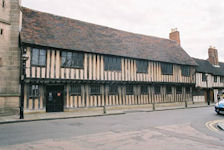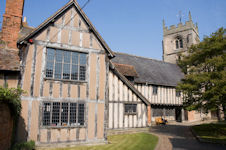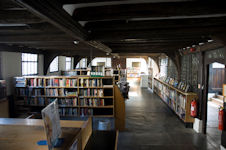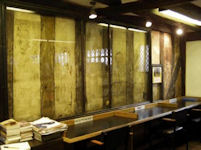

Figure 3: The Guildhall, Stratford-upon-Avon
Figure 4: The South Wing, The Guildhall, Stratford-upon-Avon
Recent research has shed important new light on the guild of the Holy Cross and its buildings (Giles and Clark forthcoming; Macdonald 2007; forthcoming). The early records of the guild indicate that from 1292 onwards, they possessed some form of chapel, hospital and common hall. By the early 15th century there were also almshouses. These buildings were established at the edge of the built-up settlement of the medieval town, at the corner of Church Street and Chapel Lane.
From c. 1417/18, the Guildhall was rebuilt as the two-storeyed, timber-framed, jettied structure that survives on the site today (Figure 3). The date of this building is supported by documentary references in the accounts to the 'new' guildhall and by recent dendrochronological analysis of the building (Giles and Clark forthcoming). An archaeological survey indicates that the building was constructed in a continuous sequence and also indicates that the South Wing, which abuts the south end of the Guildhall building, contains timbers felled at the same time and probably from the same woodland source, as those in the Guildhall (Figure 4).


Figure 3: The Guildhall, Stratford-upon-Avon
Figure 4: The South Wing, The Guildhall, Stratford-upon-Avon
The Guildhall was used for a variety of functions, including feasting and business meetings. The first floor takes the form of a medieval 'tripartite' hall, with a 'high' dais end at the north, and a 'low' end at the south, with a corridor separating the services of the Guildhall from the upper chamber of the South Wing (Figure 5). The lower floor of the Guildhall appears to have accommodated a small chapel at its south end (Figure 6). A painting of the Crucifixion, flanked by images of the Virgin and St John the Baptist, reflecting the Guild's religious dedications, survives here (Figure 7: Bailey 1898; Rutherfoord 2004). To the left of these images is the Royal Coat of Arms (England quartered with France) and on the right the arms of the Despencer family (which are possibly those of Henry de Beauchamp, Earl of Warwick, who died in 1445). At the east end of the south wall is an original 15th-century window, now blocked by the adjacent 'infill' house, while at the base of the wall are a series of mortices indicating the presence of some form of platform, probably for an altar referred to in the Guild accounts of 1424/5 (SCLA DR624/1).



Figure 5: The interior of the Upper Hall, The Guildhall, Stratford-upon-Avon, looking north
Figure 6: The interior of the Lower Hall, The Guildhall, Stratford-upon-Avon, looking north
Figure 7: Paintings at the south end of the Lower Hall, The Guildhall, Stratford-upon-Avon
The South Wing (Figure 8) appears to have functioned at ground-floor level as a 'counting' or 'counsel' house for the Guild of the Holy Cross. It also preserves traces of original painted decoration as well as a fireplace which, although much-restored, is consistent with a 15th-century date and which may well be the chimney recorded as being constructed in the 'Cowntynhows' and the chamber above, in 1427/8 (SCLA BRT1/3/38). Following incorporation, Stratford's Corporation continued to use this 'Councell chambur' as their meeting place (Savage 1921, 64). The upper floor of the South Wing always appears to have been used as a chamber and later became known as the armoury or 'harness' chamber (Savage 1926, 45).
To the east of the Guildhall is a two-range, two-storeyed building known as the 'Pedagogue's House' (Figure 9). Traditionally, it was presumed that this building was the 'Scolehowus' whose construction was referred to in the accounts of 1427/8 (SCLA BRT1/3/38). However, archaeological analysis and dendrochronological dating of the building has revised this interpretation. The timbers used in its construction were only felled in 1502 (Arnold et al. 2006, 5). The building therefore seems more likely to have been part of a rebuilding programme initiated by the Stratford merchant and guild member Thomas Hannys, whose will of 1502/3 made provision for the rebuilding of a hall, parlour, buttery, kitchen and oratory for the residents of the almshouses, which he also proposed to rebuild (TNA, PROB 11/13).
The almshouses comprise a two-storeyed timber-framed, jettied range fronting onto Church Street (Figure 10). Nine of these share a similar form of construction, with individual doorways onto the street and integral chimney stacks. Stratigraphically, they abut the first almshouse within the range, which has traditionally been known as the 'infill house'. Archaeological analysis and dendrochronology indicates that the timbers used within this building were felled in c. 1425, suggesting that this may well be the original schoolhouse of 1427/8 (Arnold and Howard 2010). This is supported by late 16th-century references to this building as 'the old school with chamber over' (SCLA BRU8/5/5).
© Internet Archaeology/Author(s)
University of York legal statements | Terms and Conditions
| File last updated: Tue Jul 25 2012